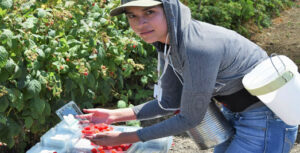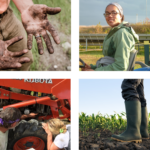 In the midst of a global pandemic, it is fair to assume everyone on your farm is feeling some level of anxiety ranging from vague discomfort to a raging sense of panic. A key role of management is setting the emotional tone for the workplace. This is especially true when you have a number of younger, entry level workers who may not have a deep pool of prior experience to draw upon. Unless you want to spend the entire growing season refereeing squabbles, drying tears, and reprimanding bad behavior now is the time to establish good communication systems. The best way to avoid trouble is to model good workplace communication with your employees and spend the time up front to establish trust and openness in the workplace.
In the midst of a global pandemic, it is fair to assume everyone on your farm is feeling some level of anxiety ranging from vague discomfort to a raging sense of panic. A key role of management is setting the emotional tone for the workplace. This is especially true when you have a number of younger, entry level workers who may not have a deep pool of prior experience to draw upon. Unless you want to spend the entire growing season refereeing squabbles, drying tears, and reprimanding bad behavior now is the time to establish good communication systems. The best way to avoid trouble is to model good workplace communication with your employees and spend the time up front to establish trust and openness in the workplace.
Following are four healthy communication practices to initiate when anxiety, fear and uncertainty are running the show.
- Lead with questions. Begin your interactions with employees by asking them questions. “How are you coping?”, “How are you feeling?”, “What are you most worried about right now?” are all good ways to check in and open the conversation. These conversations can take place one-to-one or in small groups. Be present and authentic in your questioning. Make eye contact. Limit external distractions.
Why? The human brain is not wired to take in new information when it is busy trying to solve an urgent problem. Asking questions is like mental housecleaning — they provide the opportunity to air anxieties which then creates the mental space for taking in new information.
- Listen deeply. Once a question has been asked be still and prepare to hear the response. Resist the impulse to “fix” the problem, provide advice or minimize the issue. Above all avoid judgement – what might seem insignificant to you might be legitimately terrifying to someone else. Hear what is being said, ask clarifying questions, reflect back what you think you heard. It is not necessary to be overly empathetic and there is no “right thing to say”. A good response is “thank you for trusting me with that” or “thank you for your honesty“.
Why? Truly listening is a critical step in understanding. Worry and anxiety are not always rational. Encouraging people to talk through their feelings will often make it possible for them to see for themselves where their thinking is flawed and re-frame their own issues. Hearing the concerns and fears of your team can also help you consider strategies that will help provide a sense of safety in the workplace.
- Practice being transparent, clear and open in your own communications. If you are uncertain about the future of the business, worried about your family members, anxious about creating a new business model that pushes you out of your comfort zone — share those feelings. Do not get overly dramatic or detailed but also avoid sugarcoating and unrealistic expectations. Model for others how to put fears into words. Also be clear in the steps you are taking to address your concerns and provide clear actions that you expect from every employee. Get policies, procedures and expectations down in writing — especially when things are changing rapidly it is important to keep communication simple and clear.
Why? It is not economic upheaval or pandemics that create anxiety — it is our thoughts about those events. If you begin to talk through your fears and concerns you will very likely begin to trust you have the skills and abilities to survive the current chaos. By sharing your thoughts you invite employees to do the same–you are creating a model of how to feel your feelings and still get the job done. Once the level of anxiety is lowered there may well be an opportunity to shift into shared problem-solving and brainstorming for new practices.
- Discourage gossip, rumors and trash-talk in the workplace. When people are feeling fearful and anxious there is sometimes a tendency to lash out, often in hurtful ways. This rarely ends well in the workplace and can be very disruptive. Be very clear with employees what standard of behavior is expected and why. Model respect at all times–with employees, coworkers, customers and anyone visiting the farm–you set the tone for how business is conducted. Zero tolerance for harassment of any type should be the rule.
Why? Negative talk is more contagious than any virus. It can erode trust and turn workplaces in hostile environments. Businesses that survive during times of chaos do so because they do not abandon their core values.


